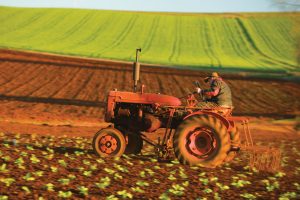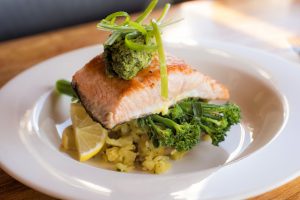





TASMANIA’S FRESH PRODUCE AND FARM GATES
Why everything in Tas just tastes better
WHAT SPARKS YOUR INTEREST?

The flavours of Tasmania are diverse and rich in both land and sea produce. Its idyllic temperatures and fertile lands offer optimal conditions for local fruits and veggies, as well as dairy production. Here, providers are both the growers and producers, making farmers’ markets, roadside stalls, and farm gates the perfect places to find fresh fruits and vegetables, and more produce. Image thanks to Tourism Tasmania & Tony Lomas.
In Tasmania, homegrown flavours are easy to come by--simply head to a village market to choose your fresh vegetables, or stop by a roadside stall for a sweet juicy apple or a delightful handful of cherries. Visit the berry farms and pick what you like (we won’t tell anyone if you sneak a few in your mouth while you’re there), and if you’re craving fresh, quality seafood, a marine farm is your next pit stop.
Are you a cheese fiend? Feast on Tasmania’s exquisite dairy products and award-winning cheeses like bries and blues, camemberts and cheddar in either local markets or specialist cheese stores.
 If your inner farmer wants to come out to play, it’s possible to take up residence in one of Tassie’s many farms, meet the growers, experience life on a ranch and learn about sustainable farming. You will even be invited to stay until the next morning. So get ready to get up-close and personal with sheep, cut and burn wood to keep you warm, and learn all about the simple life of living in and from nature during a farmstay in Tas. Image thanks to Tourism Tasmania & Rick Eaves.
If your inner farmer wants to come out to play, it’s possible to take up residence in one of Tassie’s many farms, meet the growers, experience life on a ranch and learn about sustainable farming. You will even be invited to stay until the next morning. So get ready to get up-close and personal with sheep, cut and burn wood to keep you warm, and learn all about the simple life of living in and from nature during a farmstay in Tas. Image thanks to Tourism Tasmania & Rick Eaves.
The flavours of Tasmania are seemingly endless--from its mouthwatering smoked salmon, colourful berries, chilli-infused honey and even its native seaweed. Not only are these flavours diverse and tasty, but also authentically Tasmanian.
Why is Tasmanian Fresh Produce So Good?
Inspired to cook your own fresh and delicious east coast bounty? Then make sure to keep your eyes and ears open when meeting the gardeners and farmers to get the best hands-on advice.
Types of fresh Tassie produce
Salmon
 Tasmania has an aquacultural advantage with its pollution-free waters and idyllic temperature for raising top-quality salmon. Due to its rich texture and flavour, Tasmania’s Atlantic salmon tastes amazing grilled, baked, roasted, fried or steamed with different flavours. Image thanks to Tourism Tasmania & Rob Burnett.
Tasmania has an aquacultural advantage with its pollution-free waters and idyllic temperature for raising top-quality salmon. Due to its rich texture and flavour, Tasmania’s Atlantic salmon tastes amazing grilled, baked, roasted, fried or steamed with different flavours. Image thanks to Tourism Tasmania & Rob Burnett.
Wild Abalone
 Tasmania is the world’s largest supplier of wild abalone, which is renowned for its meaty texture and distinguishable flavour. In fact, the Tasmanian abalone industry accounts for 25% of the total global production. Between 2014-15, the abalone contributed a $67 million AUD to Tassie’s export earnings. Image thanks to Tourism Australia & Ellenor Argyropoulos.
Tasmania is the world’s largest supplier of wild abalone, which is renowned for its meaty texture and distinguishable flavour. In fact, the Tasmanian abalone industry accounts for 25% of the total global production. Between 2014-15, the abalone contributed a $67 million AUD to Tassie’s export earnings. Image thanks to Tourism Australia & Ellenor Argyropoulos.
Leatherwood Honey
 Rainfall in the valleys of western Tasmania is measured in metres per annum rather than inches or centimetres--and you know what that means: the area sees more than its fair share of downpours. These just happen to be ideal conditions for the Leatherwood tree, whose flower pollen is the key ingredient for the area’s local bee population to create some superb combs dripping with some of the world’s tastiest, all-natural musky and rich honey. Image thanks to Tourism Tasmania & Nick Osborne.
Rainfall in the valleys of western Tasmania is measured in metres per annum rather than inches or centimetres--and you know what that means: the area sees more than its fair share of downpours. These just happen to be ideal conditions for the Leatherwood tree, whose flower pollen is the key ingredient for the area’s local bee population to create some superb combs dripping with some of the world’s tastiest, all-natural musky and rich honey. Image thanks to Tourism Tasmania & Nick Osborne.
Black Truffles
Organic Foods
 Organic farming means working with nature and not against it, and that means no fertilisers, GMOs or additives. In Tasmania, the local organic industry is expanding largely but steadily due to responsible consumerism, and that’s particularly easy to implement as the climate and fertile soils grace Tasmania with the opportunity to invest in organic farming. Tasmanian locals are blessed with an impressive variety of organic products from salads, fruits, vegetables, cheese, herbs, cream, milk, eggs, wine, honey, lamb, chicken, beef, potatoes, olives, carrots, beans, and even down to seeds. Image thanks to Tourism Tasmania & Kathryn Leahy.
Organic farming means working with nature and not against it, and that means no fertilisers, GMOs or additives. In Tasmania, the local organic industry is expanding largely but steadily due to responsible consumerism, and that’s particularly easy to implement as the climate and fertile soils grace Tasmania with the opportunity to invest in organic farming. Tasmanian locals are blessed with an impressive variety of organic products from salads, fruits, vegetables, cheese, herbs, cream, milk, eggs, wine, honey, lamb, chicken, beef, potatoes, olives, carrots, beans, and even down to seeds. Image thanks to Tourism Tasmania & Kathryn Leahy.
Cheese
 It doesn’t come as a surprise that cheesemakers in Tasmania are getting worldwide recognition for their renowned cheddars from Pyengana Cheese and award-winning soft white cheeses from Richmond’s Wicked Cheese factory. The cleanliness of the environment and ideal climate are factors that work to their advantage. Tasmanian cheeses vary from hard to soft, with blues, bries, cheddars, and camemberts, as well as goat and sheep milk. Image thanks to Wai Nang Poon.
It doesn’t come as a surprise that cheesemakers in Tasmania are getting worldwide recognition for their renowned cheddars from Pyengana Cheese and award-winning soft white cheeses from Richmond’s Wicked Cheese factory. The cleanliness of the environment and ideal climate are factors that work to their advantage. Tasmanian cheeses vary from hard to soft, with blues, bries, cheddars, and camemberts, as well as goat and sheep milk. Image thanks to Wai Nang Poon.
Beef
Farm Gates
Tamar Valley
 The picturesque Tamar Valley offers the ideal climate to tour around, especially with its vineyards. The area is best-known for its cherries, apples, and stone fruit--or fruits with big seeds on the inside (such as peaches, mangos, plums and lychees). Farms to look out for while in the Tamar Valley include Aviemore Farm, Hillwood Farmgate, Cherry Top Farmstay, or the Top-Qual Calthorpe Orchard roadside stall. Image thanks to Tourism Tasmania & Ilona Schneider.
The picturesque Tamar Valley offers the ideal climate to tour around, especially with its vineyards. The area is best-known for its cherries, apples, and stone fruit--or fruits with big seeds on the inside (such as peaches, mangos, plums and lychees). Farms to look out for while in the Tamar Valley include Aviemore Farm, Hillwood Farmgate, Cherry Top Farmstay, or the Top-Qual Calthorpe Orchard roadside stall. Image thanks to Tourism Tasmania & Ilona Schneider.
Coal River
Channel Region
Huon Valley
 The Huon Valley is synonymous with picture-perfect waterways and world heritage wilderness. Visitors to the region will discover some of Tasmania’s freshest land and sea produce, including shellfish, salmon, wines, apples, cherries, and berries. Popular farms to visit include Woodstock Orchards, Griggs Grower Direct Apples & Cherries, The Green Cherry Shed, Longley Organic Farm, Lucaston Park Orchards...just to scratch the surface. Image thanks to Tourism Tasmania & Adrian Cook.
The Huon Valley is synonymous with picture-perfect waterways and world heritage wilderness. Visitors to the region will discover some of Tasmania’s freshest land and sea produce, including shellfish, salmon, wines, apples, cherries, and berries. Popular farms to visit include Woodstock Orchards, Griggs Grower Direct Apples & Cherries, The Green Cherry Shed, Longley Organic Farm, Lucaston Park Orchards...just to scratch the surface. Image thanks to Tourism Tasmania & Adrian Cook.
Tasmania definitely paints a colourful, fruitful, and delicious picture, leaving little wonder that it’s favoured amongst food connoisseurs worldwide. But even the blossoming foodie can enjoy the tastes of Tasmania, with its distinguishable flavours and high-quality, fresh ingredients that make every bite, meal and feast from this island really hit the spot.






























































